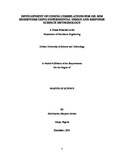| dc.contributor.author | Abdulkarim, Maryam | |
| dc.date.accessioned | 2016-10-25T11:04:45Z | |
| dc.date.available | 2016-10-25T11:04:45Z | |
| dc.date.issued | 2014-12-20 | |
| dc.identifier.uri | http://repository.aust.edu.ng/xmlui/handle/123456789/509 | |
| dc.identifier.uri | http://library.aust.edu.ng:8080/xmlui/handle/123456789/509 | |
| dc.description.abstract | Proper management of thin oil rim reservoirs is required to maximize recovery and minimizes coning tendencies. The objective of this study is to determine the effect of reservoir and fluid properties on coning tendencies in thin oil rim reservoirs and to develop numerical correlations to predict oil recovery and water break through time for these reservoirs.
Numerical correlations for the prediction of recovery and water breakthrough time using response surface methodology have been developed. The thin oil rim reservoir was represented using a generic simulation box model.
Production rate, horizontal well length, oil viscosity, vertical landing of well from the gas-oil contact (GOC), vertical permeability and anisotropy ratio were varied and their effects on oil recovery, reservoir pressure, water cut and breakthrough time were studied.
The results show that an increase in horizontal well length reduces the coning tendencies and improves recovery of oil. Increasing viscosity of oil (reducing oil mobility) increases the coning tendencies whilst reducing the productivity index of a well hence decreasing recovery. An increase in the horizontal well landing position from the gas-oil contact (GOC) results in an increase in water cut. An increase in vertical permeability and vertical anisotropy ratio both increases the coning tendencies in thin oil rim reservoirs.
Correlations for the prediction of cumulative oil recovery and water breakthrough time were developed for reservoir and fluid properties and well configurations within specific ranges which can be used for reliable predictions.
The major contribution of this work to knowledge is it presents a means of using experimental design and response surface methodology to develop reliable equations for generalized prediction of cumulative recovery and water breakthrough time in thin oil rim reservoirs without running simulation models when the required equipment and time is unavailable. | en_US |
| dc.description.sponsorship | AUST/ADB | en_US |
| dc.language.iso | en | en_US |
| dc.subject | Abdulkarim Maryam | en_US |
| dc.subject | Prof. David Ogbe | en_US |
| dc.subject | 2014 Petroleum Engineering | en_US |
| dc.subject | Oil Rim Reservoirs | en_US |
| dc.subject | Surface Methodology | en_US |
| dc.subject | Development of Coning Correlations | en_US |
| dc.subject | Reservoirs | en_US |
| dc.subject | Experimental Design | en_US |
| dc.title | Development of Coning Correlations for Oil Rim Reservoirs using Experimental Design and Response Surface Methodology | en_US |
| dc.type | Thesis | en_US |

